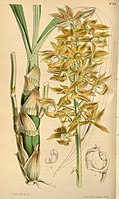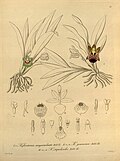
The tribe Euglossini, in the subfamily Apinae, commonly known as orchid bees or euglossine bees, are the only group of corbiculate bees whose non-parasitic members do not all possess eusocial behavior.

Coryanthes, commonly known as bucket orchids, is a genus of neotropical epiphytic orchids. This genus is abbreviated as Crths in horticultural trade. They are native to South America, Central America, Mexico and Trinidad.

Eufriesea is a genus of euglossine bees. Like all orchid bees, they are restricted to the Neotropics.

Catasetinae is a subtribe within the Orchidaceae and contains 8 genera. Its members are widespread in lowland tropical Central and South America up to 1,500 meters. They are found on trees, stumps or old fence posts.
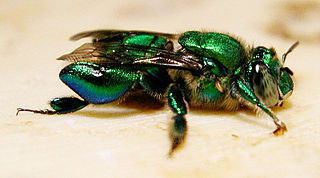
Euglossa is a genus of orchid bees (Euglossini). Like all their close relatives, they are native to the Neotropics; an introduced population exists in Florida. They are typically bright metallic blue, green, coppery, or golden.
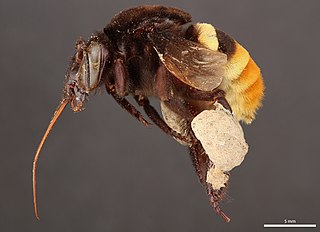
Eulaema is a genus of large-bodied euglossine bees that occur primarily in the Neotropics. They are robust brown or black bees, hairy or velvety, and often striped with yellow or orange, typically resembling bumblebees. They lack metallic coloration as occurs in the related genus Eufriesea.

Exaerete is a genus of euglossine bees found from Mexico to northern Argentina. Like all orchid bees, they are restricted to the Neotropics. All but one species is metallic green, and they are cleptoparasites in the nests of other euglossines in the genera Eufriesea and Eulaema. It contains the following species:

Aglae is a genus of euglossine bees, with the only described species Aglae caerulea. Like all orchid bees, it is restricted to the Neotropics. They are metallic blue. This species, like the genus Exaerete, is a nest parasite on free-living Euglossini. A. caerulea lays its eggs in the nests of Eulaema nigrita, and possibly other Eulaema species.
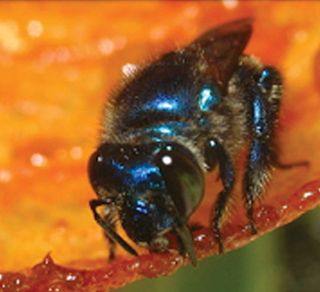
Euglossa hyacinthina, is a species of the orchid bee tribe Euglossini in the family Apidae. With a tongue that can get up to as long as 4 cm, this orchid bee species is found in Central America. Living in a neotropical climate, E.hyacinthina has adapted to hot and humid weather. The bee has darkly shaded, translucent wings and a metallic, glossy blue skeleton.
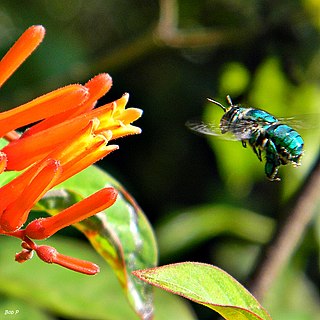
Euglossa dilemma, the green orchid bee or dilemma orchid bee, is a species of solitary euglossine bee native to a broad area of Central America, and recently introduced to Florida in the United States. It was first detected in Broward County, Florida in 2003, and initially identified as Euglossa viridissima, but further study revealed that E. viridissima as previously defined consisted of two cryptic species, and the one present in Florida was new to science.
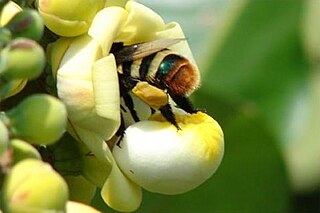
Eulaema meriana is a large-bodied bee species in the tribe Euglossini, otherwise known as the orchid bees. The species is a solitary bee and is native to tropical Central and South America. The male collects fragrances from orchid flowers, which it stores in hollows in its hind legs. Orchids can be deceptive by mimicking the form of a female and her sex pheromone, thus luring male bees or wasps. Pollination will take place as the males attempt to mate with the labellum, or the tip petal of the flower. Male E. meriana are territorial and have a particular perch on a tree trunk where it displays to attract a female. After mating, the female builds a nest with urn-shaped cells made with mud, feces, and plant resin, and provisions these with nectar and pollen before laying an egg in each. These bees also have complex foraging and wing buzzing behaviors and are part of a mimicry complex.
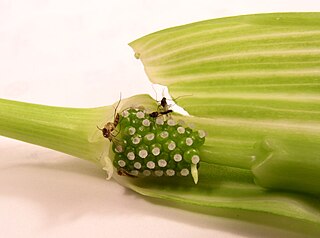
Pollination traps or trap-flowers are plant flower structures that aid the trapping of insects, mainly flies, so as to enhance their effectiveness in pollination. The structures of pollination traps can include deep tubular corollas with downward pointing hairs, slippery surfaces, adhesive liquid, attractants, flower closing and other mechanisms.

Exaerete smaragdina is a species of kleptoparasitic euglossine bees.
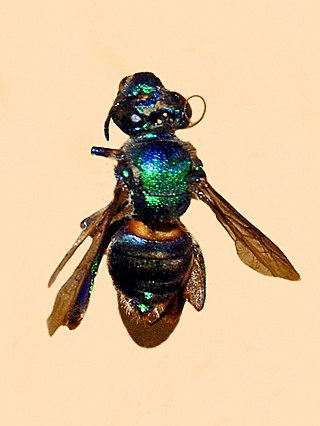
Euglossa cordata is a primitively eusocial orchid bee of the American tropics. The species is known for its green body color and ability to fly distances of over 50 km. Males mostly disperse and leave their home nests, while females have been observed to possess philopatric behavior. Because of this, sightings are rare and little is known about the species. However, it has been observed that adults who pollinate certain species of orchids will become intoxicated during the pollination.
Euglossa jacquelynae is a Euglossine bee species found in Central Brazil.
Euglossa sovietica is a Euglossine bee species found in the western Brazilian Amazon. It is believed to be part of the Euglossa purpurea group.

Eufriesea surinamensis belongs to the tribe of euglossine bees and as such is a species of orchid bee. This should not be mistaken with the species group surinamensis, which includes Ef. surinamensis among other Eufriesea species.

Euglossa imperialis is a bee species in the family Apidae. It is considered to be one of the most important pollinators to many Neotropical orchid species in mainland tropical America. It is also one of the most common non-parasitic euglossine species in lowland Panama. E. imperialis, unlike many other bee species, is not a social bee in the sense that there is no apparent morphological or physiological division within the species to distinguish individual bees to be part of a worker or reproductive caste.

Euglossopteryx is an extinct genus of bee in the family Apidae known from a fossil found in North America. There is one described species in the genus, Euglossopteryx biesmeijeri.

The pollination of orchids is a complex chapter in the biology of this family of plants that are distinguished by the complexity of their flowers and by intricate ecological interactions with their pollinator agents. It has captured the attention of numerous scientists over time, including Charles Darwin, father of the theory of evolution by natural selection. Darwin published in 1862 the first observations of the fundamental role of insects in orchid pollination, in his book The Fertilization of Orchids. Darwin stated that the varied stratagems orchids use to attract their pollinators transcend the imagination of any human being.




